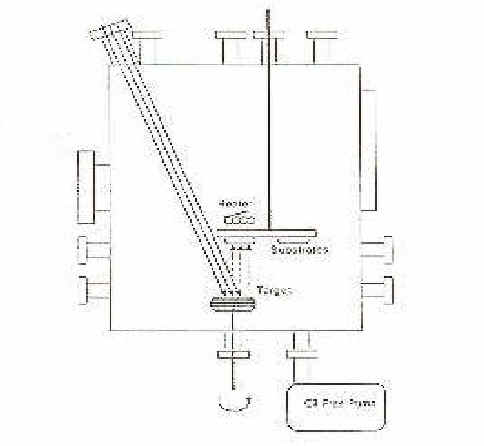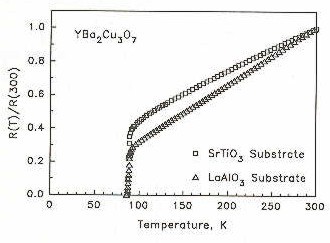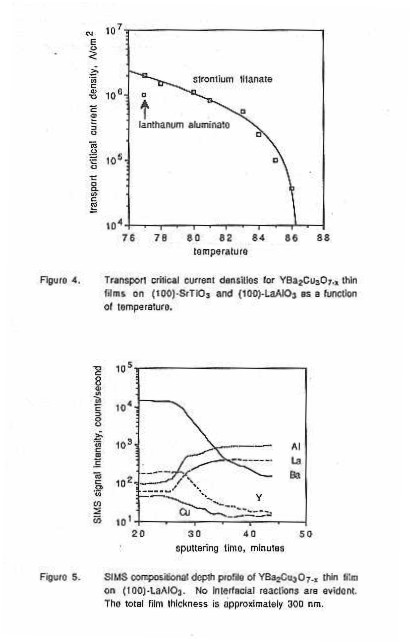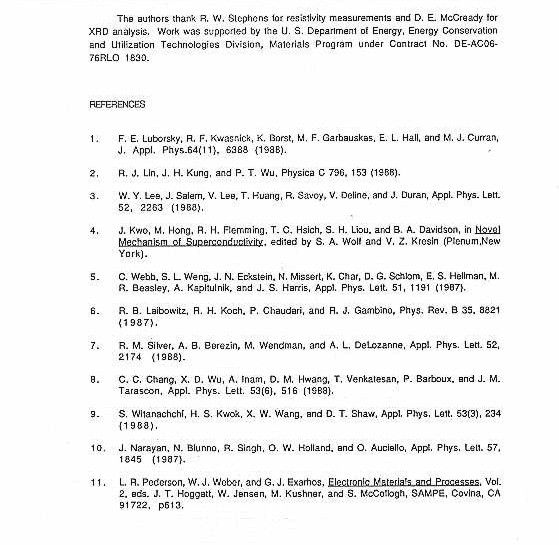
PREPARATION AND PROPERTIES OF SUPERCONDUCTING THIN FILMS BY EXCIMER LASER ABLATION
MICHAEL E. GEUSIC*, ALAN F. STEWART*, LARRY R. PEDERSON*, WILLIAM J. WEBER*, KENNETH R. MARKEN**, AND KIN LI***
*Pacific Northwest Laboratory, Richland , WA 99352
**Battelle-Columbus Laboratories, Columbus, OH 43201
***Boeing Aerospace & Electronics, Renton, WA. 98124-2499
ABSTRACT
Excimer laser ablation with an in situ heat treatment was used to prepare high quality superconducting YBa2Cu3Ox-7 thin films on (100)-SrTiO3 and (100)-LaAIO3 substrates. A pulsed excimer laser (XeCI; 308 nm) was used to ablate a rotating, bulk YBa2Cu3Ox-7 target at a laser energy density of 2-3 J/cm2. Based on four-probe dc resistance measurements, the films exhibited superconducting transition temperatures (T c' midpoint) of 88 and 87K with 2K (90-10%) transition widths for SrTiO3 and LaAIO3. respectively. Transport critical current densities (Jc) measured at 77K were 2 X 106 and 1 X 106 A/cm2 in zero field for SrTiO3 and LaAIO3, respectively. X-ray diffraction (XRD) analysis showed the films to be highly oriented, with the c-axis perpendicular to the substrate surface.
INTRODUCTION
Since the discovery of high- Tc superconductors, there has been a rapid expansion of for research into all areas of these materials. One of the areas where a considerable amount of effort has been focused is thin films. Thin films are the only form of the high- Tc superconductors that have yielded transport critical current densities above 106 A/cm2 at 77K; critical current densities for thin films are the least degraded in an applied magnetic field. Various techniques have been used for the deposition of thin films of YBa2Cu3Ox-7 on a variety of substrates. These include rf [1] and dc [2,3] sputtering, molecular beam epitaxy [4,5], thermal coevaporation [6], e-beam thermal coevaporation [7], and laser ablation [8-10]. In this paper, we report results obtained using excimer laser ablation. This technique has been one of the more widely used techniques because of its versatility, high deposition rates, reliability and reproducibility.
EXPERIMENTAL
Thin films of YBa2Cu3Ox-7 were prepared by pulsed excimer laser ablation in a rectangular stainless steel chamber, shown schematically in Figure 1. The base pressure of the chamber was normally maintained in the 10-5 torr range using an oil-free vacuum pump. An excimer laser (Lambda-Physik, EMG 53 MSC) running on XeCI (308 nm) was focused to a spot size of 5 mm2 onto a rotating, two-inch diameter, high purity YBa2Cu3Ox-7 target (Deposition Technology and SSC, Inc.). The laser was operated at a repetition rate of 3 Hz and an energy density in the range of 2-3 J/cm2, corresponding to typical deposition rates of 15-20 nm/min onto substrates positioned 4-8 cm above the target. During the deposition process, the substrate was mounted onto the face of a resistive stainless steel heater at a temperature between 680-700 °C for both SrTiO3 and LaAIO3. A flowing oxygen partial pressure of between 50-100 mtorr was maintained during the deposition. When the deposition was completed, the oxygen pressure was increased to one atmosphere and the substrate temperature was slowly lowered to 450 °C, held at that temperature for 1 hour, and then slowly lowered to room temperature. Film thicknesses were typically 0.3 to 1um.
Critical current density measurements were made using both the four-probe and magnetic susceptibility techniques. Results from magnetic susceptibility loop hysteresis were obtained by fitting to the Bean critical state model. The prefactor (k) and the sample dimension (r) were chosen to yield conservative estimates for the critical current. A criterion of 1 uV/mm was used in transport critical current density measurements. For these measurements, the films were patterned into micro-bridges 10 or 100 um wide and 2 mm long using photolithographic techniques.
Compositional depth profiles of the thin films were obtained using secondary ion mass spectrometry (SIMS), to look for evidence of film-substrate reactions as well as other possible compositional nonuniformities. A 4 keV argon ion beam was used, rastered at 2x2 mm and gated at 50 percent to eliminate unwanted signal from the sputter crater edges. Overall film compositions were also checked using Auger electron spectroscopy, inductively coupled plasma spectroscopy (ICP), and x-ray diffraction, using Cu-Ka radiation.

Figure 1. Laser deposition chamber and pumping system
RESULTS AND DISCUSSION
The composition of the thin films produced by laser ablation under the conditions described above were determined by ICP to be within 3 percent of the nominal 1 :2:3 ratio,essentially the measurement uncertainty of the technique. Auger electron spectroscopy revealed no unusual contaminants, except small quantity of adventitious carbon. No phase impurities were detected by XRD.
An examination of the microstructure using scanning electron microscopy (SEM) showed the deposited films to be smooth and free of cracks. A side view of the film revealed surface roughness to be less than 15 nm in areas where no particles were present. Particles in the <1 um size range were visible on the surface of some films, but were few in number and widely scattered. The number of surface particles tended to be minimized when the surface of the target was smooth. It can be concluded from this SEM data that the material being removed from the target during the ablation process was mainly in the form of atomic or small molecular species, which then rearrange on the growth surface.
XRD analysis showed the YBa2Cu3O7-x films to be preferentially oriented on both (100)-SrTiO3 and (100)-LaAIO3 single crystal substrates, with the c-axis oriented normal to the substrate. For films deposited on (100)-LaAIO3, only (001) reflections were visible, as given in Figure 2, corresponding to c-axis orientation only. For films on (100)-SrTiO3. although c-axis orientation predominated, both a- and c-axis orientations were found for some films.

Figure 2. X-ray diffraction scan of a YBa2Cu3O7-x thin film on LaAIO3.
Based on four-probe dc resistance measurements, YBa2Cu3O7-x thin films exhibited superconducting (midpoint) transition lemperatures of 88K with a width (90-10%) of 2K on (100)-SrTiO3. On (100)-LaAIO3, the superconducting (midpoint) transition temperature was 87K with a width of 2K. Typical results are given in Figure 3. Films on both substrates showed a metallic type behavior above the critical temperature. SimIlar properties were observed from magnetic susceptibility measurements, with a sharp diamagnetic transition measured at 90K.
Critical current densities were evaluated as a function of temperature by transport and by magnetization hysteresis methods. Critical current densities derived from magnetization hysteresis loops on (100)-SrTiO3 were 4x105 and 6x106 A/cm2 in zero applied field at 77K and 4.2K respectfully. In a 1 tesla field, results were 1x10 5 and 3x106 A/cm2 at 77K and 4.2K, respectively. Transport critical current densities in zero applied field are given as a function of temperature in Figure 4. At 77K, critical current densities of 2x106 and 1 x1 0 6A/cm2 were obtained for (100)-SrTiO3 and (100)-LaAIO3. Different samples were used to determine critical current densities by transport and by magnetization hysteresis methods, so values obtained using the two methods are not directly comparable.

Figure 3. Resistance versus temperature for SrTiO3 and LaAIO3, using four-probe dc resistance methods.
SIMS depth profiles indicated that the films were compositionally uniform and showed no evidence for substrate-film reactions at the interface. Typical results are given in Figure 5 for LaAIO3. Extensive reactions have been previously observed on substrates such as alumina [11], where barium segregation to the interface indicated formation of barium aluminate. Lower processing temperatures and the nature of the substrates both contribute to minimizing film-substrate reactions, which would adversely affect film orientation and critical properties.

